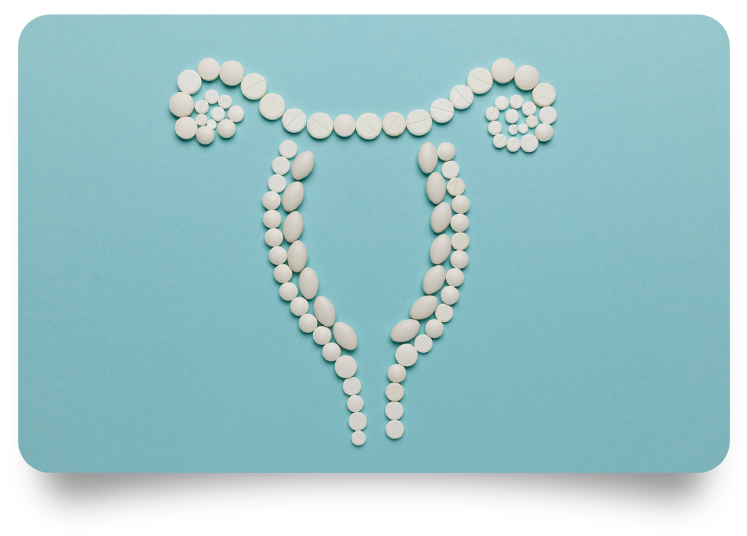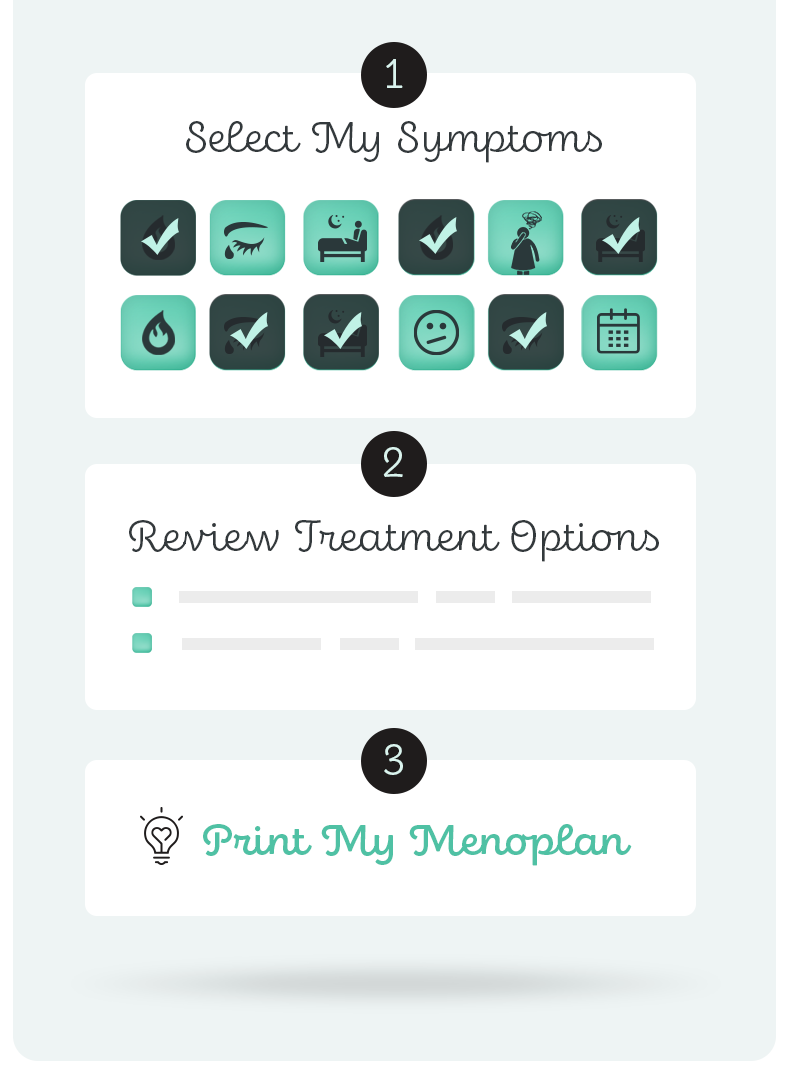Treatments
WHAT IS IT?
Estrogen is a hormone made by the ovaries. It helps prepare the body for pregnancy every month. Less estrogen is made during perimenopause and estrogen production stops almost completely once we reach menopause. This decrease in estrogen may explain some menopause symptoms. This includes the vaginal dryness, itching and pain that some women have after menopause.
While we usually think of taking estrogen as a pill, estrogen can also be delivered directly to the vaginal lining via a tablet or cream. This is a way of treating directly the vaginal symptoms. The dose used is very small, and very little of it gets into the blood stream. So, these products do not seem to carry the same risks as estrogen pills.
OUR BOTTOM LINE: DOES IT HELP?
YES. Vaginal estrogen tablets and creams help some women with vaginal symptoms.

PAIN DURING SEX
The estrogen decrease that occurs with during the menopause transition and after menopause may cause vaginal symptoms for some women. Estrogen cream and tablets work better than placebo (tablets or creams without estrogen). The effect of vaginal estrogen creams and tablets is about the same – you can decide which is best for you. An overview of studies of vaginal estrogen for genitourinary syndrome of menopause (GSM) found benefit. But findings were not consistent across studies. Vaginal dryness, itching, burning or pain with sex improved with estrogen use. While these products may help, the amount they help is modest, and most women stop using them within 6 months. Vaginal lubricants and moisturizes work as well as vaginal estrogen for some women.

VAGINAL PAIN, NOT DURING SEX
The estrogen decrease that occurs during the menopause transition and after menopause may cause vaginal symptoms for some women. Estrogen cream and tablets work better than placebo (tablets or creams without estrogen). The effect of vaginal estrogen creams and tablets is about the same – you can decide which is best for you. An overview of studies of vaginal estrogen for genitourinary syndrome of menopause (GSM) found benefit. But findings were not consistent across studies. Vaginal dryness, itching, burning or pain with sex improved with estrogen use. While these products may help, the amount they help is modest, and most women stop using them within 6 months. Vaginal moisturizers and lubricants work as well as vaginal estrogen for some women.

BLADDER CONTROL PROBLEMS
Vaginal estrogen can help a little with how often you urinate and the sudden feeling of urgency. In studies, women who used vaginal estrogen had one to two fewer voids per day compared to women who used a placebo drug. It seemed to work for women who have both bladder and vaginal symptoms. But more research is needed. Know that pelvic floor muscle training works better than vaginal estrogen.

LOW SEX DRIVE
Vaginal estrogen may help postmenopausal women who have low libido because sex is painful. In women who had have their ovaries removed, testosterone may also help. But our research suggests that you should try an over-the-counter vaginal lubricant first, because it may be as effective as vaginal estrogen.
POTENTIAL RISKS & SIDE EFFECTS
Vaginal estrogen creams and tablets are generally safe. The lower dose vaginal estrogen creams and tablets are sufficient to treat vaginal symptoms and do not require taking progesterone. The higher estrogen dose found in some vaginal rings (Femring) do require progesterone. Progesterone limits overgrowth of the uterine lining (precancer or cancer of the endometrium) that can occur with higher doses of estrogen. Vaginal estrogens increase the risk of yeast infections by about 5%. When taken at low doses they do not increase the risk of uterine or breast cancers.
IF I WANT TO TRY THIS TREATMENT WHAT ARE MY NEXT STEPS?
Beginning treatment depends on the vaginal symptom(s). If you have vaginal itching, pain with urination, or vaginal discharge, see your provider. For pain with sexual activity, first try plant-based lubricants. These may or may not help for vaginal dryness or pain felt at other times (without sexual activity). If the vagina is too tight, try vaginal dilators and a referral for pelvic physical therapy. A counselor may help you talk about this with your partner. If symptoms do not resolve, or if you do not like using a lubricant, or your symptom is constant dryness, what next? Try vaginal estrogen. Vaginal estrogen requires a prescription.
What if you still have pain with sex and you have had no benefit from the other treatments (vaginal estrogen, vaginal lubricants)? Discuss DHEA (Intrarosa) or ospemifene (Osphena) with your provider. However, depending on your insurance, these can be costly therapies.
The perfect treatment for menopausal vaginal symptoms has not been developed, mainly because we do not fully understand the cause(s) of the symptoms. Postmenopausal women have skin changes of the vagina and vulva related to decreased estrogen – the skin becomes thinner and smoother, with decreased blood flow and aging nerves. These changes are seen on physical examination and are called genitourinary atrophy. But not all women with vaginal signs of atrophy have vaginal symptoms and when they do, the degree of atrophy does not correlate with the severity of symptoms. The estrogen decrease that occurs with menopause may prompt symptoms for some women but replacing local hormones does not always effectively treat vaginal symptoms and women with atrophy on examination may improve with nonhormonal therapies.
Lethaby A, Ayeleke RO, Roberts H. Local oestrogen for vaginal atrophy in postmenopausal women. Cochrane Database Syst Rev. 2016;2016(8):CD001500. Published 2016 Aug 31. doi:10.1002/14651858.CD001500.pub3. PMID: 27577677
Management of symptomatic vulvovaginal atrophy: 2013 position statement of The North American Menopause Society. Menopause. 2013;20(9):888-904. doi:10.1097/GME.0b013e3182a122c2. PMID: 23985562
Mitchell CM, Reed SD, Diem S, et al. Efficacy of Vaginal Estradiol or Vaginal Moisturizer vs Placebo for Treating Postmenopausal Vulvovaginal Symptoms: A Randomized Clinical Trial. JAMA Intern Med. 2018;178(5):681-690. doi:10.1001/jamainternmed.2018.0116. PMID: 29554173
Sarri G, DaviesM, Lumsden MA, Guideline Development Group. Diagnosis and management of menopause: summary of NICE guidance. BMJ. 2015;351:h5746. Published 2015 Nov 12. doi:10.1136/bmj.h5746. PMID: 26563259
Shulman LP, Portman DJ, Lee WC, Balu Sanjeev, Joshi AV, Cobden D, Wang Q, Pashos CL. A retrospective managed care claims data analysis of medication adherence to vaginal estrogen therapy: implications for clinical practice. J Womens Health (Larchmt). 2008;17(4):569-578. doi:10.1089/jwh.2007.0407. PMID: 18429700
Rahn DD, Carberry C, Sanses TV, Mamik MM, Ward RM, Meriwether KV, Olivera CK, Abed H, Balk EM, Murphy M, Society of Gynecologic Surgeons Systematic Review Group. Vaginal estrogen for genitourinary syndrome of menopause: a systematic review. Obstet Gynecol. 2014;124(6):1147-1156. doi:10.1097/AOG.0000000000000526. PMID: 25415166
Authors: Dr. Susan Reed, Dr. Katherine Newton, & Dr. Leslie Snyder. Last reviewed February 15, 2021



